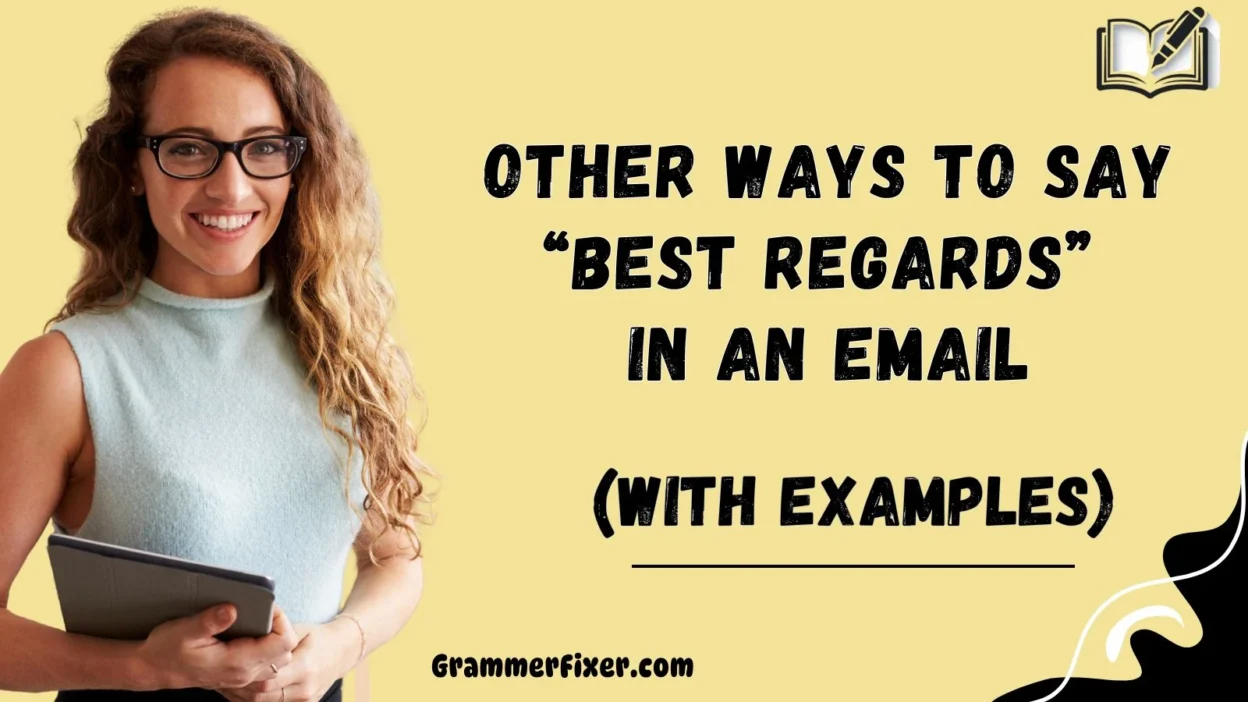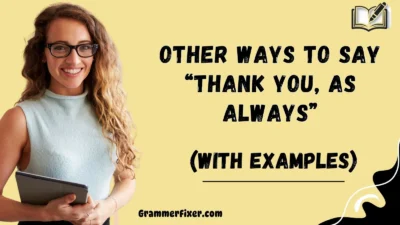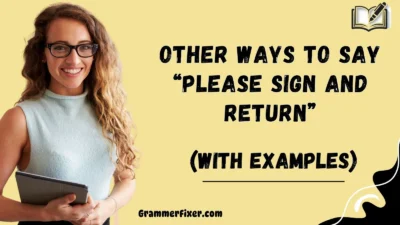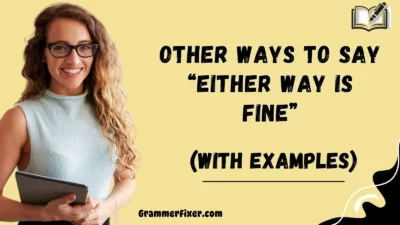Finding the right words to close an email can make all the difference. While “Best Regards” is polite and safe, using the same phrase repeatedly may feel repetitive or generic. By choosing thoughtful alternatives, you can add a more personal touch, strengthen your professionalism, and leave your recipient with a warmer impression.
Below, you’ll find 30 meaningful alternatives to say “Best Regards,” complete with meanings, scenarios, and examples so you can tailor your sign-offs to different communications.
What Does “Best Regards” Mean?
“Best Regards” is a professional and polite way to close an email or letter. It conveys respect, goodwill, and friendliness without being overly formal. Essentially, it’s a neutral, courteous closing suitable for most business communications.
When to Use “Best Regards”?
Use “Best Regards” when you want to strike a balance between professionalism and warmth. It works well in general business correspondence, cover letters, or when addressing colleagues, clients, or vendors in a respectful but approachable tone.
Is It Professional/Polite to Say “Best Regards”?
Yes. “Best Regards” is universally accepted as a safe, professional, and polite closing. It demonstrates courteous decorum and is unlikely to be misinterpreted. However, overuse may cause it to feel stale or insincere.
Pros or Cons
Pros:
- Widely recognized and respected
- Suitable for both formal and less formal situations
- Maintains professional decorum
Cons:
- May feel generic if used too often
- Lacks strong personalization
- Doesn’t always match casual or creative contexts
1. Kind Regards
Meaning: A softer, slightly warmer version of Best Regards.
Explanation: Often used in professional correspondence, it conveys both politeness and a touch of friendliness.
Scenario Example: “I look forward to your feedback on the proposal. Kind Regards, Michael.”
Best Use: When emailing clients, colleagues, or in business proposals.
Worst Use: In very casual emails to friends or family—it may feel stiff or unnecessarily formal.
Tone: Professional, polite, approachable.
2. Warm Regards
Meaning: A more personalized and friendly alternative.
Explanation: Adds a layer of warmth to your message, showing care for the recipient.
Scenario Example: “Thank you for sharing your insights today. Warm Regards, Sarah.”
Best Use: With coworkers you know well or clients you’ve built a rapport with.
Worst Use: In highly formal settings like a job application or legal correspondence—it may seem too casual.
Tone: Friendly, warm, semi-formal.
3. Sincerely
Meaning: A classic, time-tested sign-off.
Explanation: Frequently used in cover letters and formal correspondence. It signals authenticity and seriousness.
Scenario Example: “Please let me know if I can provide more details. Sincerely, Robert.”
Best Use: Job applications, formal letters, and government documents.
Worst Use: In casual emails to friends or team members—it may feel overly stiff and outdated.
Tone: Formal, respectful.
4. Sincerely Yours
Meaning: A slightly more personal extension of “Sincerely.”
Explanation: Adds a touch of earnestness and deference.
Scenario Example: “I appreciate your time in reviewing the documents. Sincerely Yours, Emily Stone.”
Best Use: Formal communications, especially when showing utmost respect.
Worst Use: Everyday workplace emails or quick notes, as it can come across as old-fashioned or overly formal.
Tone: Formal, deferential, respectful.
5. Yours Truly
Meaning: A traditional closing expressing honesty and genuine intent.
Explanation: Often seen in formal correspondence, it conveys a sense of trustworthiness and authenticity.
Scenario Example: “Thank you for considering my application. Yours Truly, Jonathan Freeman.”
Best Use: In formal letters or applications where respect and formality are important.
Worst Use: In modern casual workplace emails—it may feel overly old-fashioned or distant.
Tone: Formal, respectful, traditional.
6. Respectfully
Meaning: Shows deference and utmost respect toward the recipient.
Explanation: Ideal when communicating with higher-ups, officials, or when discussing serious matters.
Scenario Example: “Thank you for your guidance on this project. Respectfully, Caroline Pierce.”
Best Use: When addressing superiors, clients, or government officials.
Worst Use: In lighthearted or casual emails, where it can feel overly stiff or excessive.
Tone: Formal, serious, deferential.
7. Respectfully Yours
Meaning: A slightly warmer version of “Respectfully.”
Explanation: Adds a personal touch while still maintaining decorum.
Scenario Example: “I greatly appreciate your time and insights. Respectfully Yours, James Howlett.”
Best Use: In official communications, particularly when you want to show genuine appreciation.
Worst Use: In casual workplace banter or everyday check-ins—it comes across as unnecessarily formal.
Tone: Formal, appreciative, deferential.
8. With Gratitude
Meaning: Expresses thankfulness and sincere appreciation.
Explanation: Stronger than “Best Regards,” it emphasizes gratitude for support, time, or effort.
Scenario Example: “Thank you for reviewing the draft so quickly. With Gratitude, Susan Storm.”
Best Use: After someone has provided assistance, guidance, or support.
Worst Use: In neutral, no-emotion emails where gratitude isn’t relevant—it may feel forced.
Tone: Warm, appreciative, heartfelt.
9. With Sincere Appreciation
Meaning: A more formal and elaborate way of showing appreciation.
Explanation: Best used when you want to underscore respect and thankfulness in a professional setting.
Scenario Example: “I deeply value your contributions to this project. With Sincere Appreciation, Robert Sand.”
Best Use: When acknowledging efforts, achievements, or collaborations.
Worst Use: In short, everyday emails—it can sound overdone for small matters.
Tone: Formal, respectful, grateful.
10. With Gratitude and Respect
Meaning: Combines both thankfulness and deference.
Explanation: Useful in situations where you want to highlight both appreciation and respect toward the recipient.
Scenario Example: “Your input was invaluable during the review process. With Gratitude and Respect, Martha Freeman.”
Best Use: Communicating with mentors, leaders, or senior colleagues.
Worst Use: Casual communication, like team updates or quick check-ins, where it feels overly ceremonial.
Tone: Formal, deeply respectful, appreciative.
11. All the Best
Meaning: A warm and versatile closing wishing the recipient well.
Explanation: Common in both professional and personal correspondence, it conveys positivity without being overly formal.
Scenario Example: “I’ll follow up with the revised timeline next week. All the Best, Rachel.”
Best Use: Semi-formal settings like colleague updates or client emails where a friendly tone works.
Worst Use: In very formal documents like a government letter or legal notice—it may feel too casual.
Tone: Friendly, approachable, versatile.
12. Best Wishes
Meaning: Conveys good intentions and positive regard for the recipient’s success or wellbeing.
Explanation: Slightly warmer than “Best Regards,” often used in congratulatory or supportive contexts.
Scenario Example: “Good luck with your upcoming presentation. Best Wishes, Serena.”
Best Use: When celebrating achievements, milestones, or sending well-wishes.
Worst Use: In strictly transactional emails (like sending invoices)—it might feel unnecessary.
Tone: Positive, supportive, kind.
13. Warmly
Meaning: A simple, one-word sign-off that adds friendliness and warmth.
Explanation: Best for emails where you want to appear approachable and personable without losing professionalism.
Scenario Example: “It was a pleasure catching up today. Warmly, Jane.”
Best Use: Emails to coworkers, clients you have a relationship with, or casual professional conversations.
Worst Use: In formal job applications or when emailing senior officials—it may seem too casual.
Tone: Friendly, warm, semi-formal.
14. Cheers
Meaning: A casual, upbeat way to end an email.
Explanation: Popular in British English and increasingly used globally, it conveys friendliness and a relaxed tone.
Scenario Example: “Thanks for sending over the draft. Cheers, Adam.”
Best Use: Informal communication with colleagues, team members, or familiar clients.
Worst Use: In formal business emails or to unfamiliar recipients, where it may come off as unprofessional.
Tone: Casual, friendly, approachable.
15. Take Care
Meaning: Shows concern and goodwill for the recipient’s wellbeing.
Explanation: Adds a personal and caring note, making it more thoughtful than standard closings.
Scenario Example: “Wishing you a restful weekend. Take Care, Emily.”
Best Use: Semi-professional or casual workplace relationships, especially after a personal exchange.
Worst Use: In very formal or transactional business settings, where it may feel out of place.
Tone: Caring, personal, considerate.
16. Have a Great Day
Meaning: A cheerful and positive closing that wishes the recipient well for the rest of their day.
Explanation: Creates a friendly and upbeat ending, often used in casual workplace interactions.
Scenario Example: “Thanks again for your help with the report. Have a Great Day, John.”
Best Use: Emails to colleagues, coworkers, or clients where a light, approachable tone is welcome.
Worst Use: In serious or sensitive communications (e.g., legal, medical, or disciplinary emails) where a cheerful tone may feel inappropriate.
Tone: Positive, casual, upbeat.
17. Have a Great Weekend
Meaning: A warm, time-specific sign-off that acknowledges upcoming downtime.
Explanation: Helps build rapport by showing personal consideration beyond the work itself.
Scenario Example: “Looking forward to connecting next week. Have a Great Weekend, Sarah.”
Best Use: Toward the end of the week, when communicating with coworkers, clients, or teams.
Worst Use: In mid-week or formal communications—it can seem irrelevant or misplaced.
Tone: Warm, friendly, thoughtful.
18. Talk Soon
Meaning: Suggests an expectation of future communication.
Explanation: Creates a sense of openness and continuity, reinforcing an ongoing relationship.
Scenario Example: “I’ll send over the draft tomorrow. Talk Soon, Michael.”
Best Use: With colleagues, clients, or collaborators you’re regularly in touch with.
Worst Use: In formal or one-off emails, such as job applications or official proposals—it might feel presumptuous.
Tone: Friendly, semi-casual, approachable.
19. Speak Soon
Meaning: Similar to “Talk Soon,” but carries a slightly more formal edge.
Explanation: Often used in professional contexts to imply a follow-up or continued discussion.
Scenario Example: “Thanks for your insights today. Speak Soon, Robert.”
Best Use: When you have a scheduled meeting or anticipate further dialogue.
Worst Use: In situations where no follow-up is planned—it may sound misleading.
Tone: Semi-formal, approachable, professional.
20. Looking Forward
Meaning: Expresses anticipation for future engagement.
Explanation: Conveys enthusiasm and positivity, suggesting that you’re eager for what’s next.
Scenario Example: “I’m eager to review your feedback on the strategy. Looking Forward, Caroline.”
Best Use: When awaiting a response, feedback, or collaboration.
Worst Use: In finalized communications where no next step exists—it can feel awkward.
Tone: Optimistic, forward-looking, professional.
21. Yours Faithfully
Meaning: A formal closing used when you don’t know the recipient’s name.
Explanation: Traditional in British English correspondence, especially in formal letters.
Scenario Example: “I am writing to submit my application for the role. Yours Faithfully, Thomas Walker.”
Best Use: Cover letters, formal proposals, and official correspondence where the recipient’s name is unknown.
Worst Use: In casual or modern workplace emails, it feels outdated and overly formal.
Tone: Formal, respectful, traditional.
22. Yours Sincerely
Meaning: A classic and polite sign-off when addressing someone by name.
Explanation: Pairs well with “Dear Mr./Ms. [Last Name]” and signals seriousness and courtesy.
Scenario Example: “Please find attached the requested documents. Yours Sincerely, Samantha Beckett.”
Best Use: Job applications, business letters, and legal documents.
Worst Use: In casual team emails or with close colleagues—it sounds unnecessarily stiff.
Tone: Formal, courteous, professional.
23. Cordially
Meaning: A formal yet warm and respectful closing.
Explanation: Slightly more elegant than “Sincerely,” it conveys politeness with a hint of friendliness.
Scenario Example: “I’d be happy to discuss this further at your convenience. Cordially, Jonathan Parker.”
Best Use: In business proposals, client introductions, or formal invitations.
Worst Use: For casual workplace chats or short, transactional emails—it feels too heavy.
Tone: Formal, polished, courteous.
24. Faithfully Yours
Meaning: A variation of “Yours Faithfully,” carrying extra deference.
Explanation: Expresses deep respect and works well in traditional or very formal contexts.
Scenario Example: “Thank you for reviewing my submission. Faithfully Yours, Diane Larson.”
Best Use: Formal letters, government correspondence, or ceremonial communication.
Worst Use: In emails with colleagues or everyday office updates, it comes across as overly ceremonial.
Tone: Formal, deferential, respectful.
25. Yours Respectfully
Meaning: A mix of sincerity and politeness, showing consideration toward the recipient.
Explanation: Stronger than simply “Respectfully,” it highlights professional courtesy.
Scenario Example: “I truly value your perspective on this matter. Yours Respectfully, Oliver Hunt.”
Best Use: When writing to executives, senior officials, or in formal proposals.
Worst Use: In casual internal team conversations or light updates—it will feel unnecessarily formal.
Tone: Polite, professional, respectful.
26. With Appreciation
Meaning: Expresses thankfulness in a professional yet warm way.
Explanation: A great choice when someone has provided assistance, feedback, or support.
Scenario Example: “I value your input on the recent proposal. With Appreciation, Jenna Thompson.”
Best Use: After receiving guidance, feedback, or help from colleagues, clients, or mentors.
Worst Use: In neutral or purely transactional emails, it can feel unnecessary or overdone.
Tone: Grateful, professional, warm.
27. With Gratitude
Meaning: A heartfelt expression of deep thankfulness.
Explanation: Conveys genuine emotional sincerity, often stronger than a simple thank you.
Scenario Example: “Your support on this project has been invaluable. With Gratitude, Marcus Jackson.”
Best Use: When acknowledging mentorship, collaboration, or significant contributions.
Worst Use: In routine updates or everyday workplace chats—it may feel exaggerated.
Tone: Heartfelt, sincere, appreciative.
28. Yours Truly (Casual Twist)
Meaning: While traditionally formal, it can be used in a slightly relaxed, modern sense with familiar colleagues.
Explanation: Can show both respect and warmth, depending on tone.
Scenario Example: “It’s been a pleasure working with you this quarter. Yours Truly, Christina Shore.”
Best Use: With long-term clients, trusted colleagues, or mentors.
Worst Use: In short or purely technical emails where such warmth is unnecessary.
Tone: Warm, respectful, adaptable.
29. Best
Meaning: A shortened, modern variation of “Best Regards.”
Explanation: Crisp, simple, and widely used in professional correspondence today.
Scenario Example: “I’ll send over the final draft by Friday. Best, Peter Applegarth.”
Best Use: Everyday workplace communications when you want to remain professional but brief.
Worst Use: In highly formal documents—it may feel too minimal and casual.
Tone: Professional, concise, modern.
30. Fond Regards
Meaning: A warm and slightly personal closing, showing friendliness and goodwill.
Explanation: Best used when you want to express affectionate respect without being unprofessional.
Scenario Example: “It was wonderful collaborating with you on this project. Fond Regards, Susan Storm.”
Best Use: Emails with longstanding colleagues, partners, or collaborators where a relationship already exists.
Worst Use: In formal or first-time professional communications, it may sound overly intimate.
Tone: Warm, personal, thoughtful.
Conclusion
Email closings may seem like a small detail, but they carry a lot of weight in shaping the tone of your message and the impression you leave. While “Best Regards” is a trusted, professional go-to, relying on it every time can make your communication feel repetitive or impersonal.
By exploring these 30 alternatives, you now have a toolkit of options that range from formal and respectful to casual and approachable. The key is choosing a closing that matches your intent, audience, and context.
- Use formal sign-offs when writing to clients, executives, or in official documents.
- Use casual yet professional closings when emailing colleagues, peers, or ongoing collaborators.
- Use warm and personal endings when you want to show appreciation or strengthen relationships.



